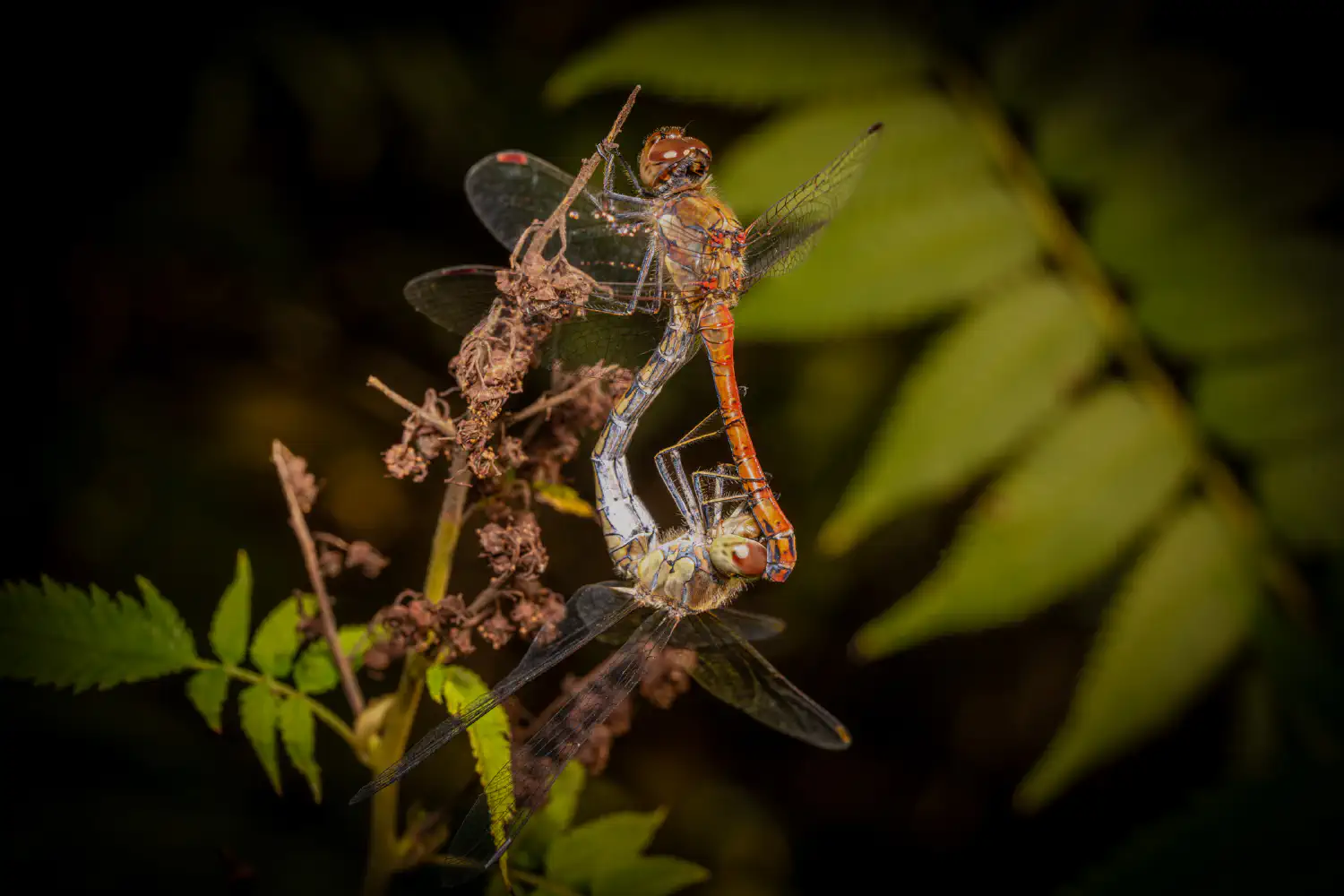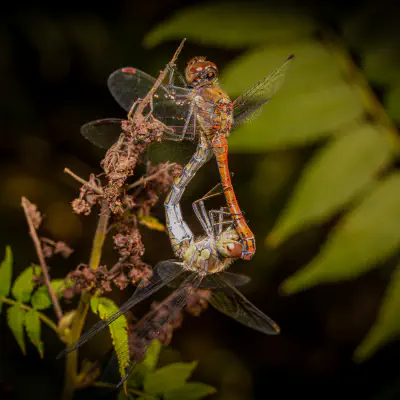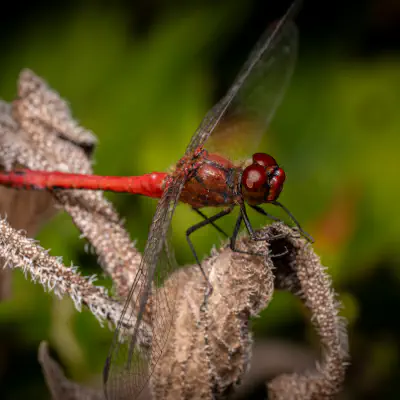Dragonflies Lat. “Anisoptera“
A dragonfly is an insect belonging to the order Odonata, infraorder Anisoptera (from Greek ἄνισος anisos, “uneven” and πτερόν pteron, “wing”, because the hindwing is broader than the forewing). Adult dragonflies are characterized by large, multifaceted eyes, two pairs of strong, transparent wings, sometimes with coloured patches, and an elongated body. Dragonflies can be mistaken for the related group, damselflies (Zygoptera), which are similar in structure, though usually lighter in build; however, the wings of most…
Hierarchy
Etymology
The infraorder Anisoptera comes from Greek ἄνισος anisos “unequal” and πτερόν pteron “wing” because dragonflies’ hindwings are broader than their forewings.
Evolution
Dragonflies and their relatives are similar in structure to an ancient group, the Meganisoptera or griffinflies, from the 325 Mya Upper Carboniferous of Europe. This group includes one of the largest insects that ever lived, Meganeuropsis permiana from the Early Permian, which had a wingspan of around 750 mm (30 in). The Protanisoptera, another ancestral group that lacks certain wing-vein characters found in modern Odonata, lived in the Permian. Anisoptera first appeared during the Toarcian age of the Early Jurassic, and the crown group developed in the Middle Jurassic. They retain some traits of their distant predecessors, and are in a group known as the Palaeoptera, meaning ‘ancient-winged’. Like the gigantic griffinflies, dragonflies lack the ability to fold their wings up against their bodies in the way that many modern insects can, although some evolved their own different way to do so. The forerunners of modern Odonata are included in a clade called the Panodonata, which include the basal Zygoptera (damselflies) and the Anisoptera (true dragonflies). Today, some 3,000 species are extant around the world. The relationships of anisopteran families are not fully resolved as of 2021, but all the families are monophyletic except the Corduliidae, and the Aeshnoidea are sister to the remaining families:
Distribution and diversity
About 3,012 species of dragonflies were known in 2010; these are classified into 348 genera in 11 families. The distribution of diversity within the biogeographical regions is summarized below (the world numbers are not ordinary totals, as overlaps in species occur).
Dragonflies live on every continent except Antarctica. In contrast to the damselflies (Zygoptera), which tend to have restricted distributions, some genera and species are spread across continents. For example, the blue-eyed darner Rhionaeschna multicolor lives across North America, and in Central America; emperors Anax live throughout the Americas from as far north as Newfoundland to as far south as Bahia Blanca in Argentina, across Europe to central Asia, North Africa, and the Middle East. The globe skimmer Pantala flavescens is probably the most cosmopolitan, occurring on all continents in the warmer regions. Most Anisoptera species are tropical, with far fewer species in temperate regions. Some dragonflies, including libellulids and aeshnids, live in desert pools. In the Mojave Desert they are active in shade temperatures between 18 and 45 °C (64 and 113 °F); these dragonflies survive body temperatures fatal to individuals not adapted to that environment, even those of the same species. Dragonflies live from sea level up to the mountains, decreasing in species diversity with altitude. Their altitudinal limit is about 3700 m, represented by a species of Aeshna in the Pamirs. Dragonflies become scarce at higher latitudes. They are not native to Iceland, but individuals are occasionally swept in by strong winds, including a Hemianax ephippiger native to North Africa, and an unidentified darter species. In Kamchatka, only a few species of dragonfly including the treeline emerald Somatochlora arctica and some aeshnids such as Aeshna subarctica are found, possibly because of the low temperature of the lakes there. The treeline emerald also lives in northern Alaska, within the Arctic Circle, making it the most northerly of all dragonflies.
Predators
Although dragonflies are swift and agile fliers, some predators are fast enough to catch them. These include falcons such as the American kestrel, the merlin, and the hobby. Nighthawks, swifts, flycatchers and swallows also take some adults. Some wasps prey on dragonflies, laying an egg on each captured insect to provision their nests. In the water, various species of ducks and herons eat dragonfly nymphs and they are also preyed on by newts, frogs, fish, and water spiders. Amur falcons, which migrate over the Indian Ocean at a period that coincides with the migration of the globe skimmer dragonfly, Pantala flavescens, may actually be feeding on them while on the wing.
Parasites
Dragonflies are affected by three groups of parasites: water mites, gregarine protozoa, and trematode flatworms (flukes). Water mites, Hydracarina, can kill smaller dragonfly nymphs, and may also be seen on adults. Gregarines infect the gut and may cause blockage and secondary infection. Trematodes are parasites of vertebrates such as frogs, with complex life cycles often involving a period as a stage called a cercaria in a secondary host, a snail. Dragonfly nymphs may swallow cercariae, or these may tunnel through a nymph’s body wall; they then enter the gut and form a cyst or metacercaria, which remains in the nymph for the whole of its development. If the nymph is eaten by a frog, the amphibian becomes infected by the adult or fluke stage of the trematode.
External links
The dictionary definition of dragonfly at Wiktionary Media related to Anisoptera at Wikimedia Commons Data related to Anisoptera at Wikispecies
Ancestry Graph
Further Information
„Dragonflies“ on wikipedia.org
„Dragonflies“ on iNaturalist.org
Copyright

This article uses material from the Wikipedia article Anisoptera the free encyclopedia Wikipedia which is released under Creative Commons Attribution-ShareAlike 4.0 International License). On Wikipedia a list of authors is available.

Little beings in print
Order our calendars and books today!
Compiled with love. Printed sustainably. Experience our little beings even more vividly in print. All our publications are available for a small donation.



